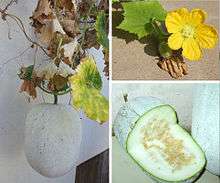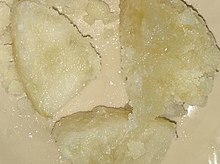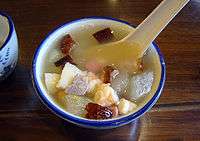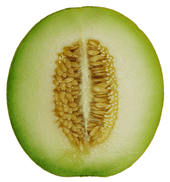Wax gourd
Benincasa hispida, the wax gourd,[2][3] also called ash gourd,[4] white gourd, winter gourd, tallow gourd, ash pumpkin, winter melon,[4] Chinese preserving melon[4] and (Alu) Puhul, is a vine grown for its very large fruit, eaten as a vegetable when mature.
| Wax gourd | |
|---|---|
 | |
| Wax gourd plant, flower and immature and mature fruit | |
| Scientific classification | |
| Kingdom: | Plantae |
| Clade: | Tracheophytes |
| Clade: | Angiosperms |
| Clade: | Eudicots |
| Clade: | Rosids |
| Order: | Cucurbitales |
| Family: | Cucurbitaceae |
| Subfamily: | Cucurbitoideae |
| Tribe: | Benincaseae |
| Genus: | Benincasa Savi |
| Species: | B. hispida |
| Binomial name | |
| Benincasa hispida (Thunb.) Cogn. | |
| Synonyms[1] | |
|
List
| |
| Nutritional value per 100 g (3.5 oz) | |
|---|---|
| Energy | 54 kJ (13 kcal) |
3 g | |
| Dietary fiber | 2.9 g |
0.2 g | |
0.4 g | |
| |
| †Percentages are roughly approximated using US recommendations for adults. Source: USDA Nutrient Database | |
It is the only member of the genus Benincasa. The fruit is covered in a fuzzy coating of fine hairs when young. The immature melon has thick white flesh that tastes sweet. By maturity, the fruit loses its hairs and develops a waxy coating, giving rise to the name wax gourd. The wax coating helps to give the fruit a long shelf life. The melon may grow as large as 80 cm in length. It has yellow flowers and broad leaves.[5] The taste is rather bland.[6]
It is native to South and Southeast Asia. The wax gourd is widely grown throughout Asia,[7] including Java and Japan,[8] the places where it is thought to have originated and Sri Lanka.[5]
One variety of the plant, called chi-qua (Benincasa hispida var. chieh-qua), is commonly used in Asian cuisine.[9]
Etymology
The name "winter melon" that is sometimes given to this plant is based on the Chinese name dōngguā (冬瓜); however, the character 瓜 (guā) can also mean “gourd” or “squash.”[10] It is likely that the name “melon” is given because this gourd is sometimes candied or made into a sweet tea.
Cultivation
It is grown in well-drained loam and sandy soils in warm, mild climates, and will not tolerate frosts. It is grown in riverbeds or furrows, and needs constant irrigation during the growing season.[5]
Uses
The wax gourd can be stored for many months, much like winter squash. Ash gourds of the Indian subcontinent have a white coating with a rough texture (hence the name ash gourd). Southeast Asian varieties have a smooth waxy texture. It is one of the few vegetables available during winter in areas of deciduous vegetation. In India, the wax gourd is recognized for its medicinal properties in the Ayurvedic system of medicine.[8] It also has significance in spiritual traditions of India and Yoga, where it is identified as a great source of prana.[11]

In Vietnamese cuisine, it is called bí đao, and is usually used to make soup or stew.[12] When cooked with pork short ribs, the resulting soup is traditionally thought to help produce more milk for breastfeeding mothers.
In Chinese cuisine, the gourds are used in stir fries or combined with pork or pork/beef bones to make winter gourd soup, often served in the scooped out gourd, carved by scraping off the waxy coating. It is also chopped and candied[13] as wintermelon candy (táng dōng guā), commonly eaten at New Year festivals, or as filling for Sweetheart cake (lǎopó bǐng). It has also been used as the base filling in Chinese and Taiwanese mooncakes for the Moon Festival.
In the Philippines it is candied (referred to plainly as kundol) and is used as a pastry filling for bakpia (hopia in the Philippines). It is also an ingredient in some savory soups (sabaw) and stir-fries (guisado).
In Indian cuisine it is traditionally used to prepare a wide variety of dishes. In northern India it is used to prepare a candy called petha. In South Indian cuisine, it is traditionally used to make a variety of curries, including a stew made with a yogurt base.[14] The juice of the raw ash gourd (Maipawl or Khar) is used by the Mizo community and indigenous Assamese ethnicities of North-East India as a natural remedy to treat mild to severe dysentery. In north India, particularly in the middle Himalayas, it is paired with pulses such as moong which, when crushed, along with winter gourd, make a dish locally called bori. When dried in sunlight it becomes somewhat hard and is used in curry dishes and eaten with rice or chapati. This practice is especially prevalent in the Himalayas due to the long shelf life of the resulting product.
In Andhra Pradesh, it is called "boodidi gummidikaya" (Telugu language). It is used to make stews, stir fries and vadialu. Vadialu (plural; vadiam is singular) are made by chopping the gourd in small pieces and mixing with yogurt and spices, then sun-drying. To eat, vadialu are deep fried in oil and eaten as an accompaniment to rice and sambar or lentil stews.
In Kerala, the plant is called Kumbalam (കുമ്പളം) and the fruit is called Kumbalanga (കുമ്പളങ്ങ) or Kooshmandam (കൂശ്മാണ്ടം). It is traditionally used to offer 'Guruthi' (ഗുരുതി) instead of 'Kuruti' (കുരുതി) among Malayali Brahmins. Thus, instead of offering someone's life in the pier, an ash gourd is cut into two as a symbolic performance in lieu of human sacrifice.
In Udupi cuisine, the ash gourd is known as Budu Kumbda or Boldu Kumbda in the Tulu language, Budi Kumblakayi in Kannada is used to prepare dishes like Kodel (Sambhar), Ale bajji, Kashi Halwa and chutney.[15]
In Gujarat, is called kolu (કોળુ).
In Nepal, where it is called Kubhindo, it is cooked as a vegetable when young, but the ripe gourds are usually made into preserves or crystallized candy known as "murabba" or "petha".[16]
Occasionally, it is used to produce a fruit drink with a distinctive taste. It is usually sweetened with caramelized sugar. In Southeast Asia, the drink is marketed as wax gourd tea or wax gourd punch.
The shoots, tendrils, and leaves of the plant may also be eaten as greens.[17]
2020 Mystery Seed Mail
In summer of 2020, several states across the U.S. reported mysterious, unsolicited packages containing unknown and unidentified seeds of various kinds - the envelopes presented Chinese text in many cases. At least one person planted one type of these seeds, which grew and was analyzed before state officials destroyed the plant. This proved to be Benincasa hispida (wax gourd, Chinese melon)[18].
Gallery
 Indian ash gourd
Indian ash gourd Nearly mature wax gourd
Nearly mature wax gourd Wax gourd
Wax gourd Seeds
Seeds Wax gourd on the vine
Wax gourd on the vine Chinese winter melon soup
Chinese winter melon soup Chinese winter melon candy
Chinese winter melon candy Wax gourd plant flowering
Wax gourd plant flowering Wax gourd two weeks after flowering
Wax gourd two weeks after flowering
References
- "The Plant List: A Working List of All Plant Species". Retrieved April 10, 2014.
- Wax Gourd, Editors of 'Encyclopædia Britannica'. Accessed on 19.11.2012.
- Useful Tropical Plants, 'Benincasa hispida'. Accessed on 19.11.2017.
- "Multilingual Multiscript Plant Name Database". Retrieved 10 April 2014.
- D. K. Salunkhe and S. S. Kadam (Editors)Handbook of Vegetable Science and Technology: Production, Composition, Storage and Processing, p. 290, at Google Books
- Specialty Produce, 'Winter Melon'. Accessed on 19.11.2017.
- "Benincasa hispida - Plant Finder". www.missouribotanicalgarden.org.
- T. R. Gopalakrishnan Vegetable Crops, p. 138, at Google Books
- "Chi qua (Benincasa hispida var. chieh-gua)". NSW Government Department of Primary Industries. State of New South Wales. Archived from the original on 2020-05-12. Retrieved 2020-05-11.
- MDBG Word Dictionary
- "Ash Gourd (Winter Melon), the "Cool" Vegetable: Benefits & Recipes - The Isha Blog". The Isha Blog. 2017-05-04. Retrieved 2018-02-16.
- "Winter Melon Soup - Canh Bí Đao". youtube.com. 30 August 2014. Retrieved 1 June 2017.
- "How to make Candied Winter Melon aka Tung Kua(冬瓜糖)". 2009. Retrieved 18 December 2011.
- "Majjige huli with winter melon".
- "Ashgourd Kootu Recipe Simple and easy". Retrieved 10 January 2020.
- Taste of Nepal, 'Kubhindo - Ash Gourd (कुभिन्डो)'. Accessed 19.11.2017.
- "~Winter Squash Leaves in Salted Coconut Milk". praneesthaikitchen.com. 9 August 2011. Retrieved 2 June 2017.
- "Arkansas man plants mystery seeds from China; USDA preps to destroy". foxnews.com. 12 August 2020. Retrieved 12 August 2020.
External links

